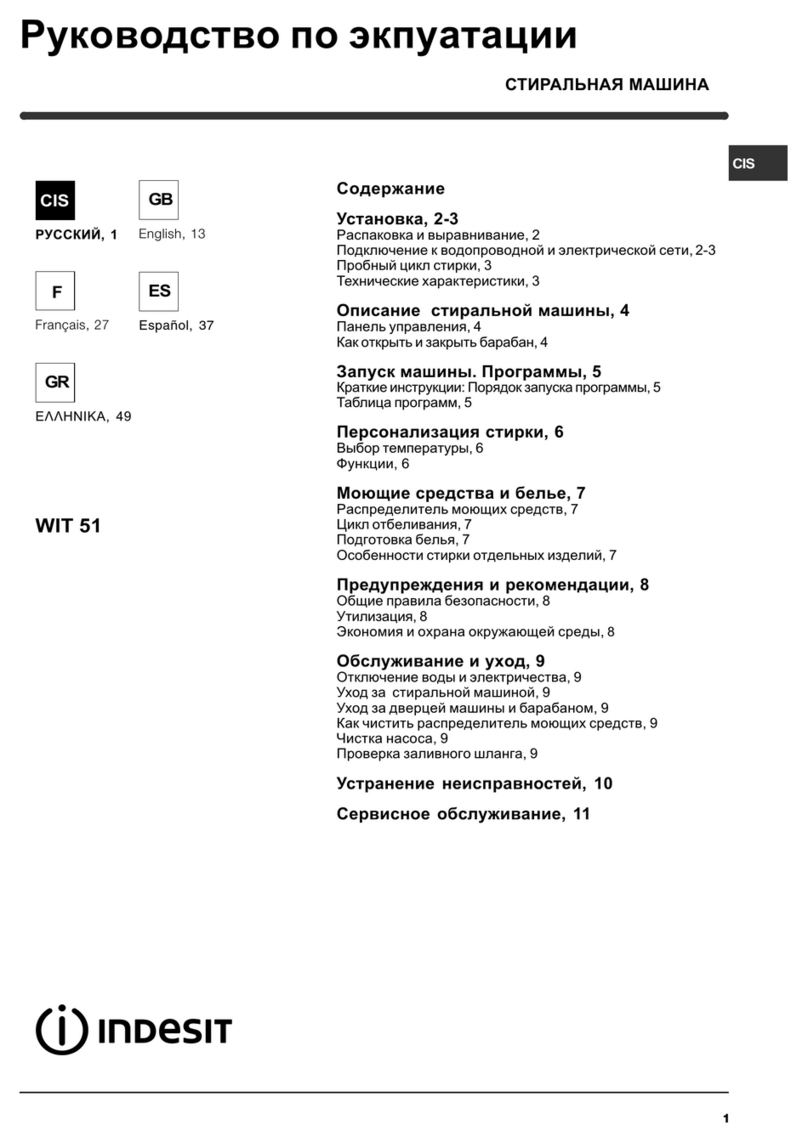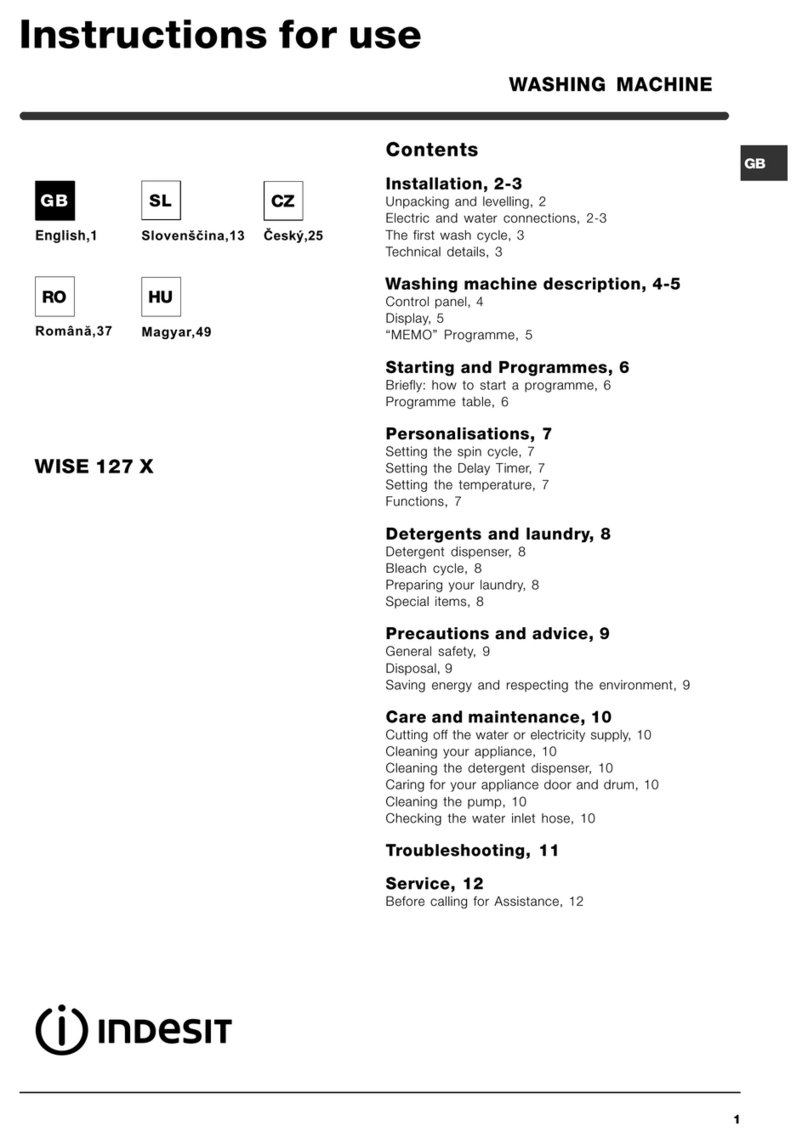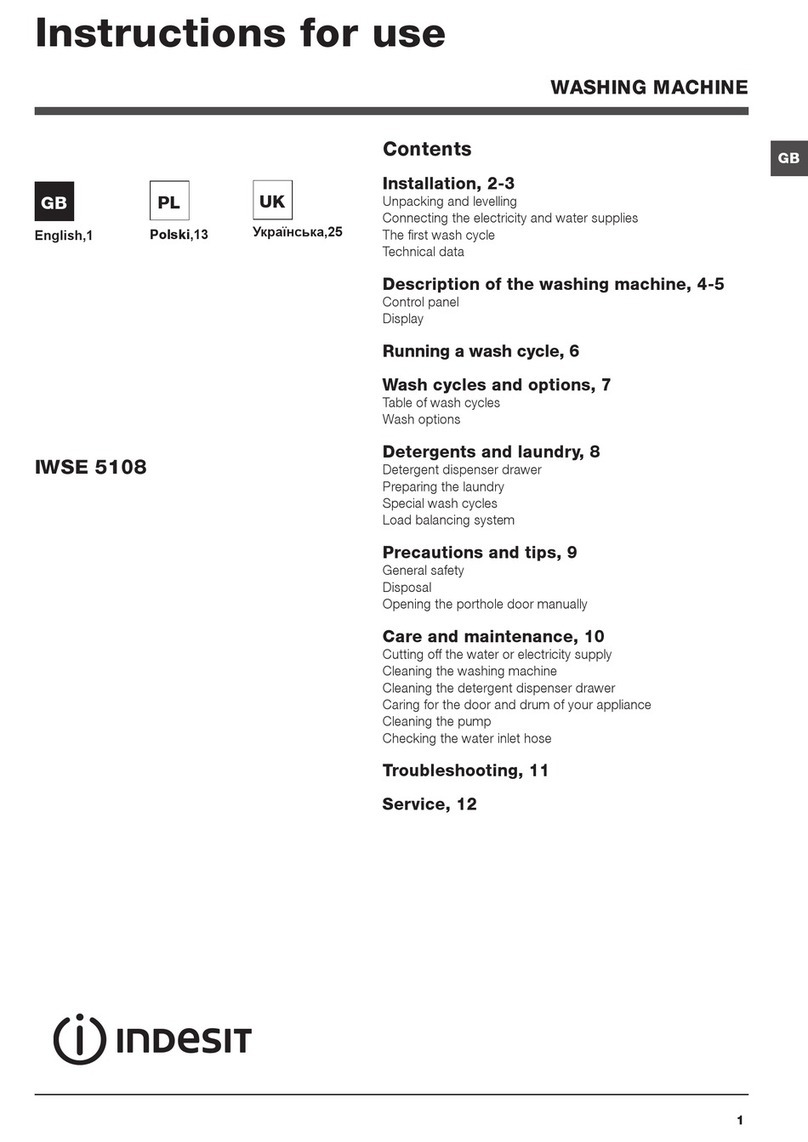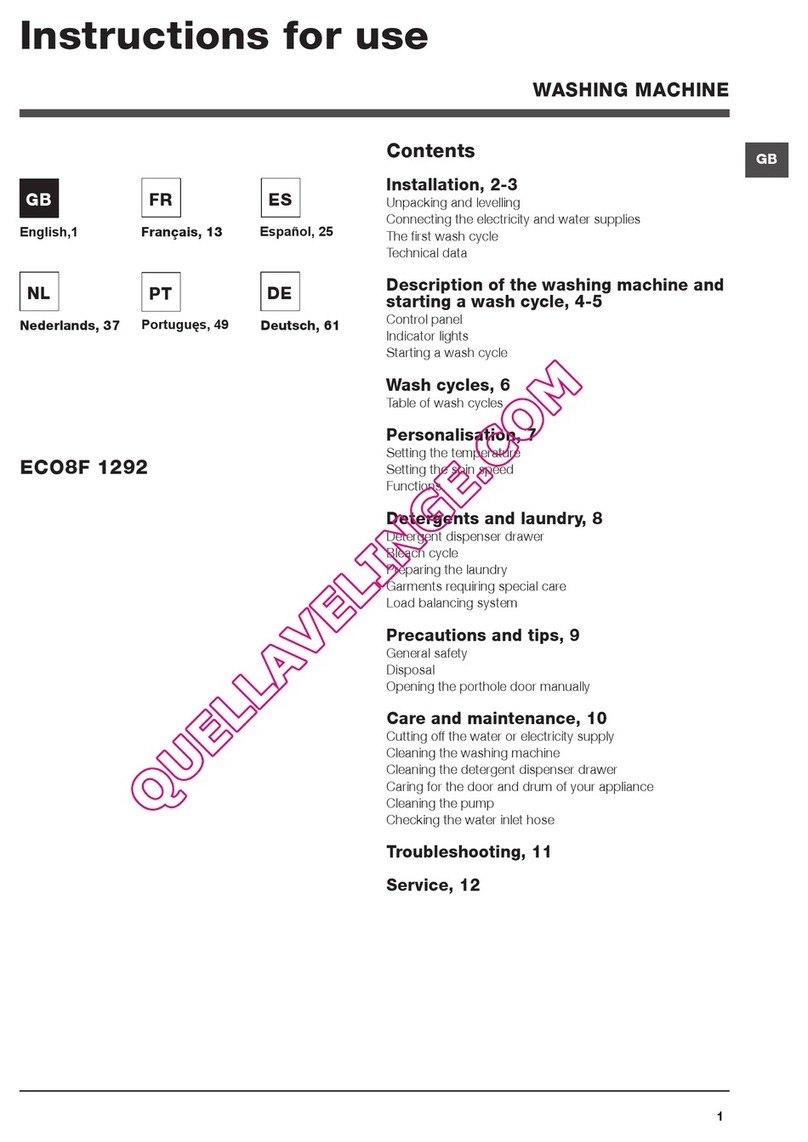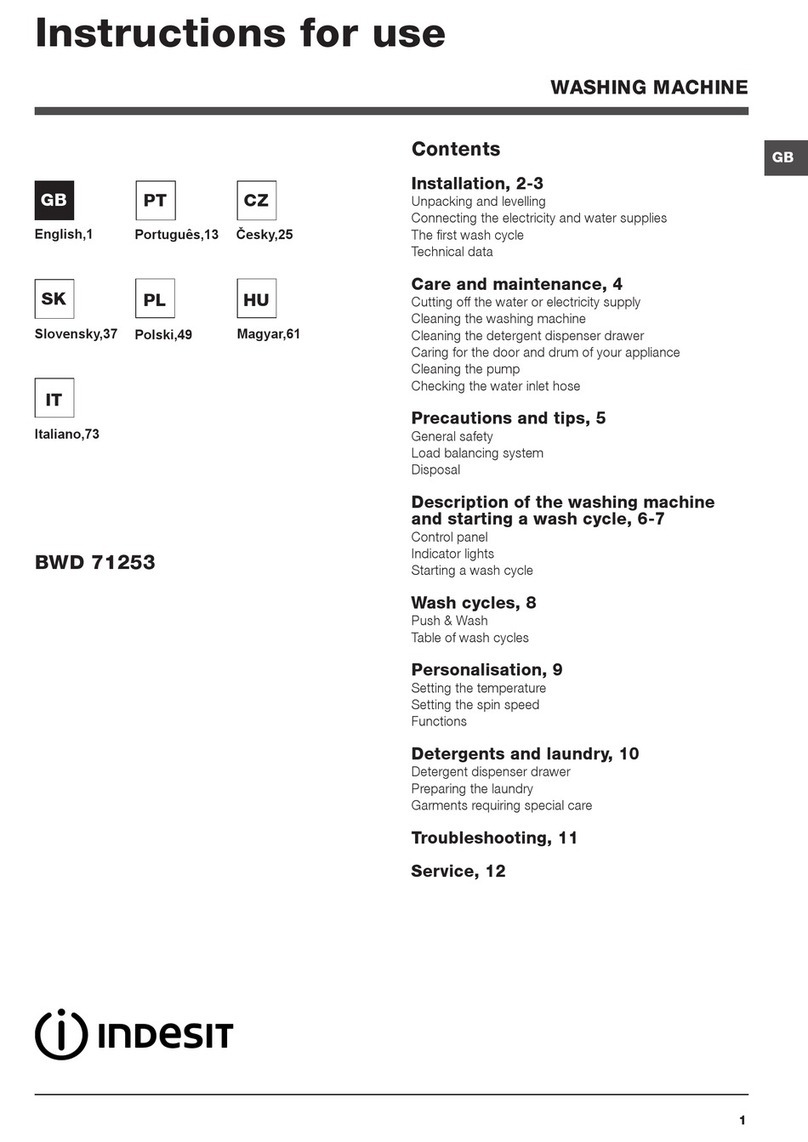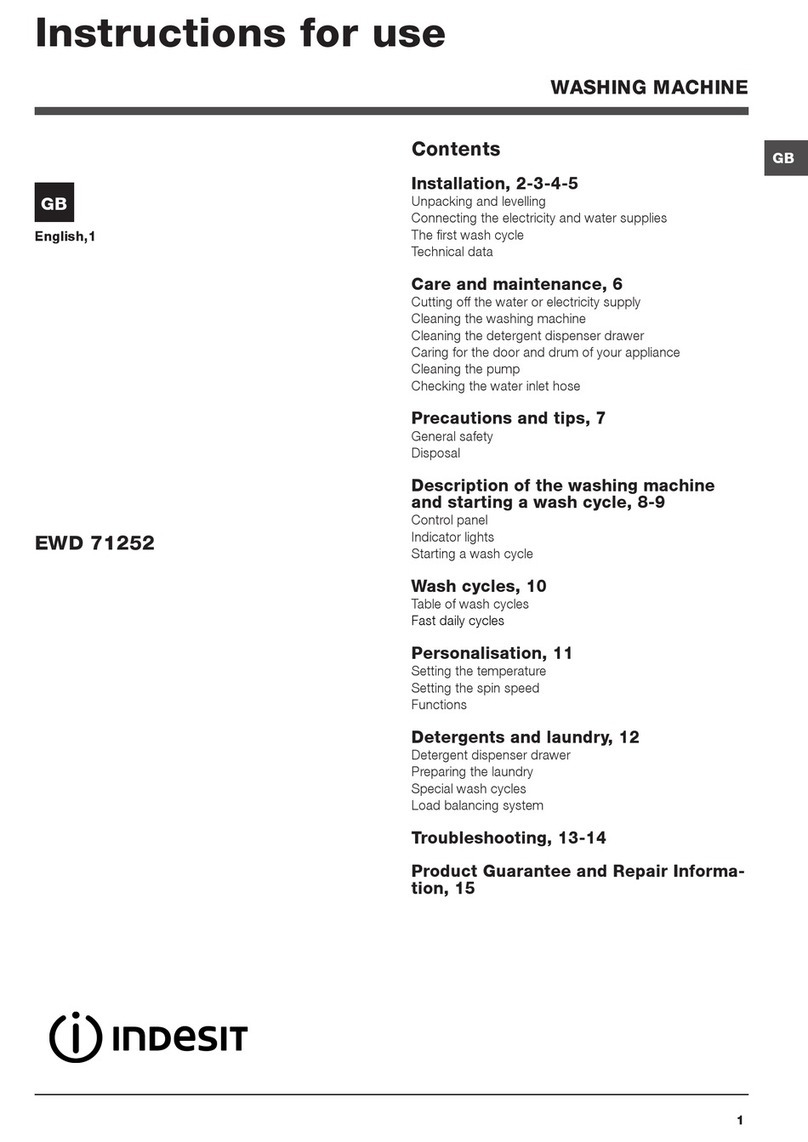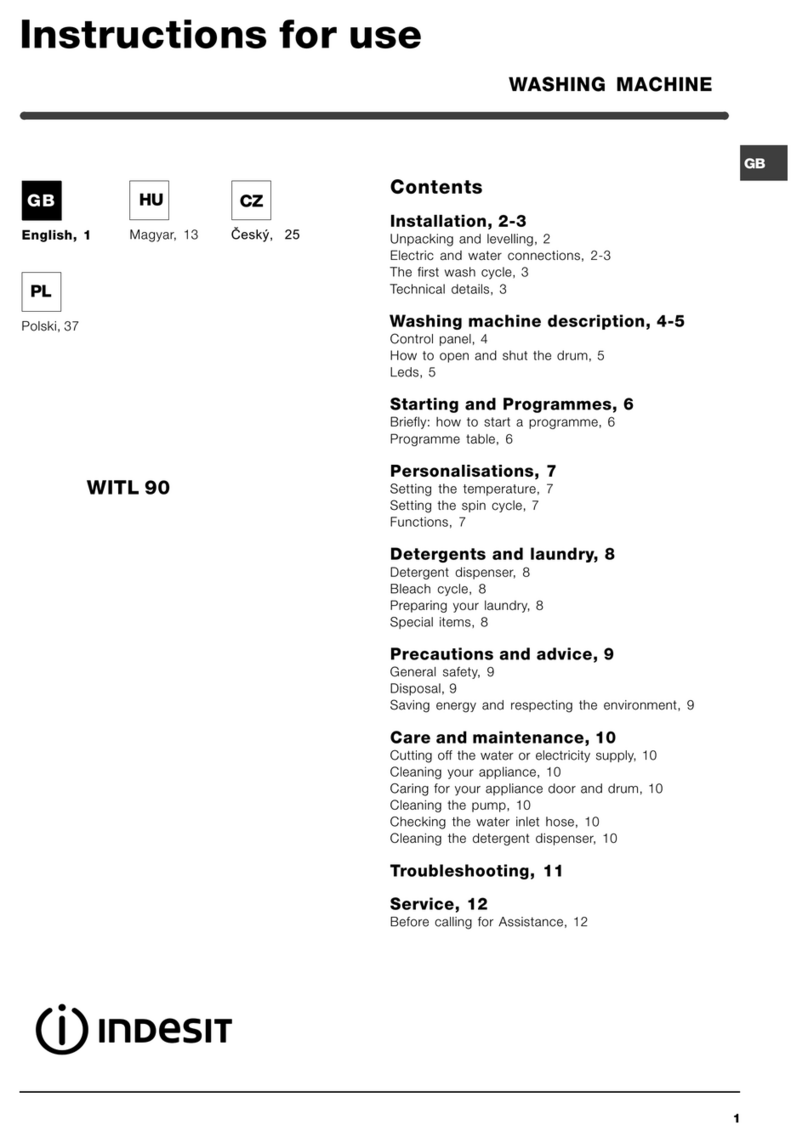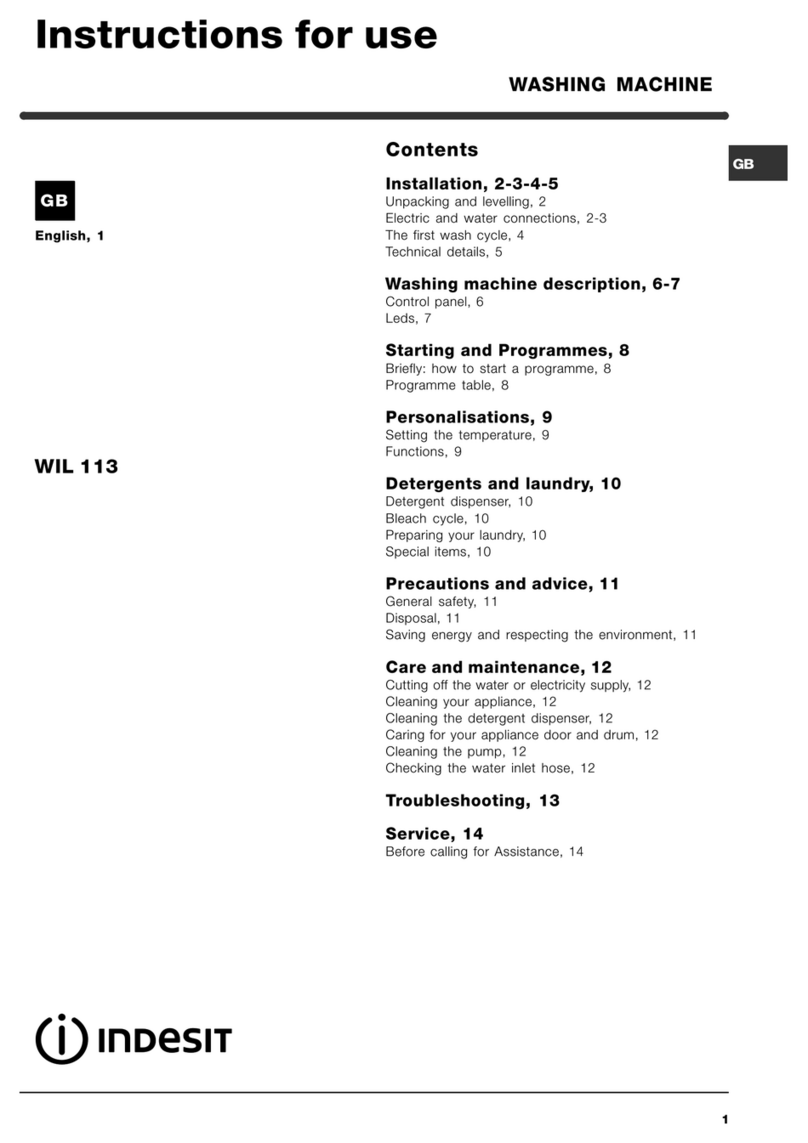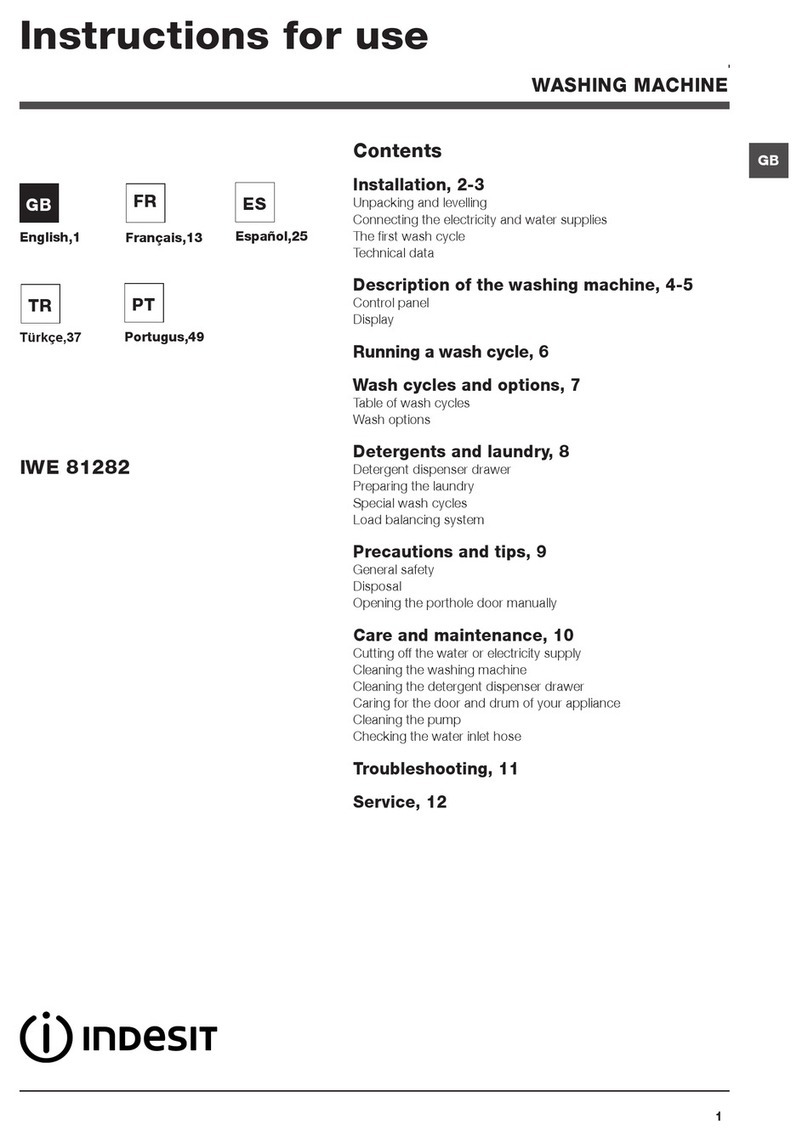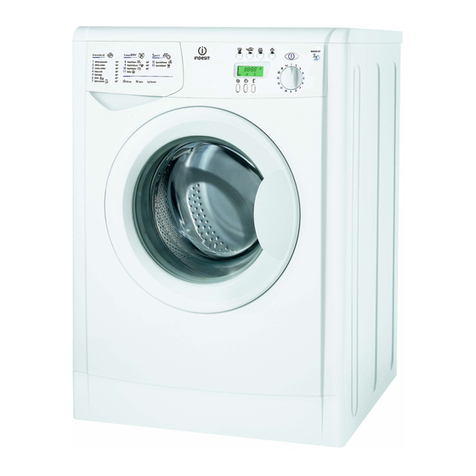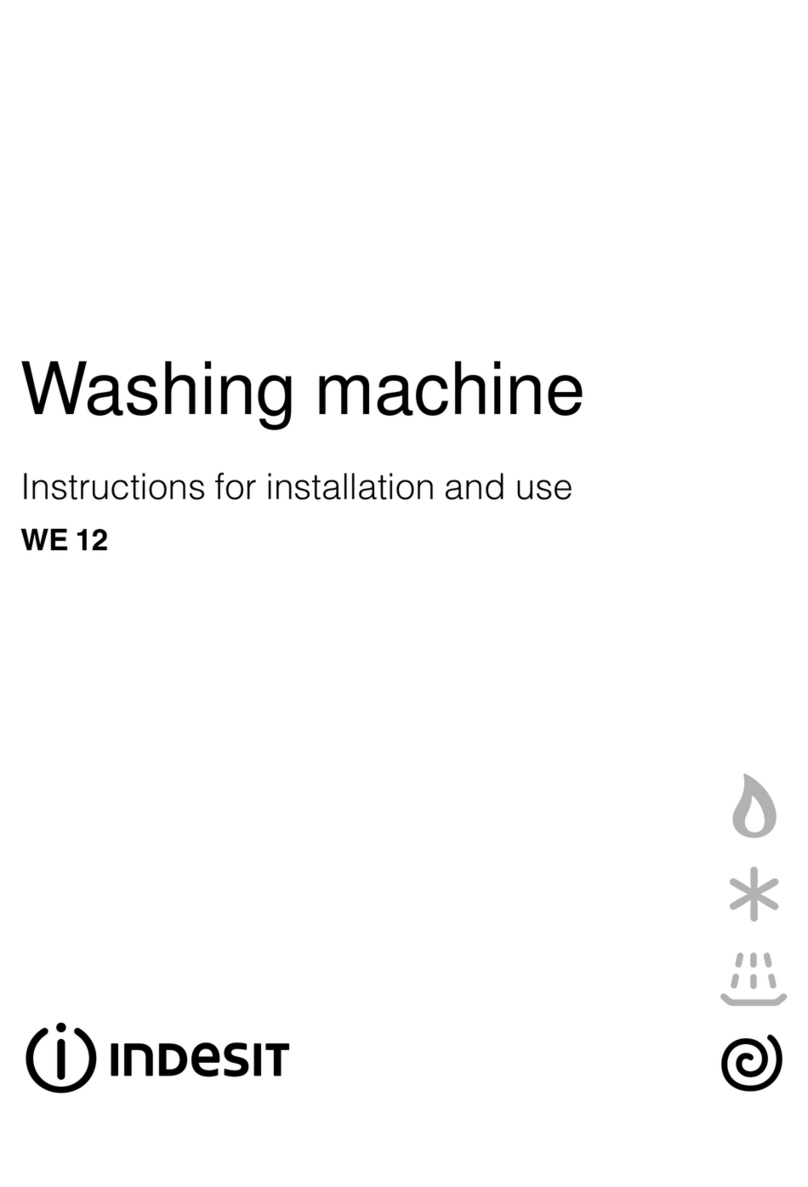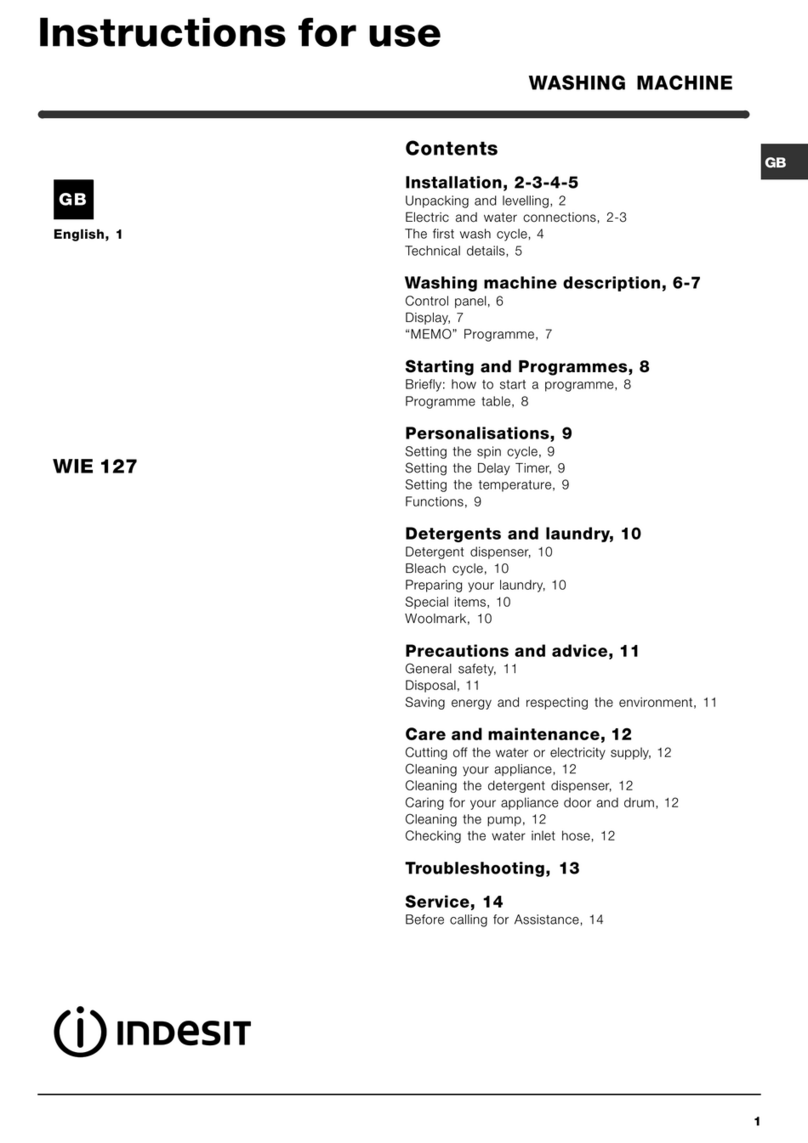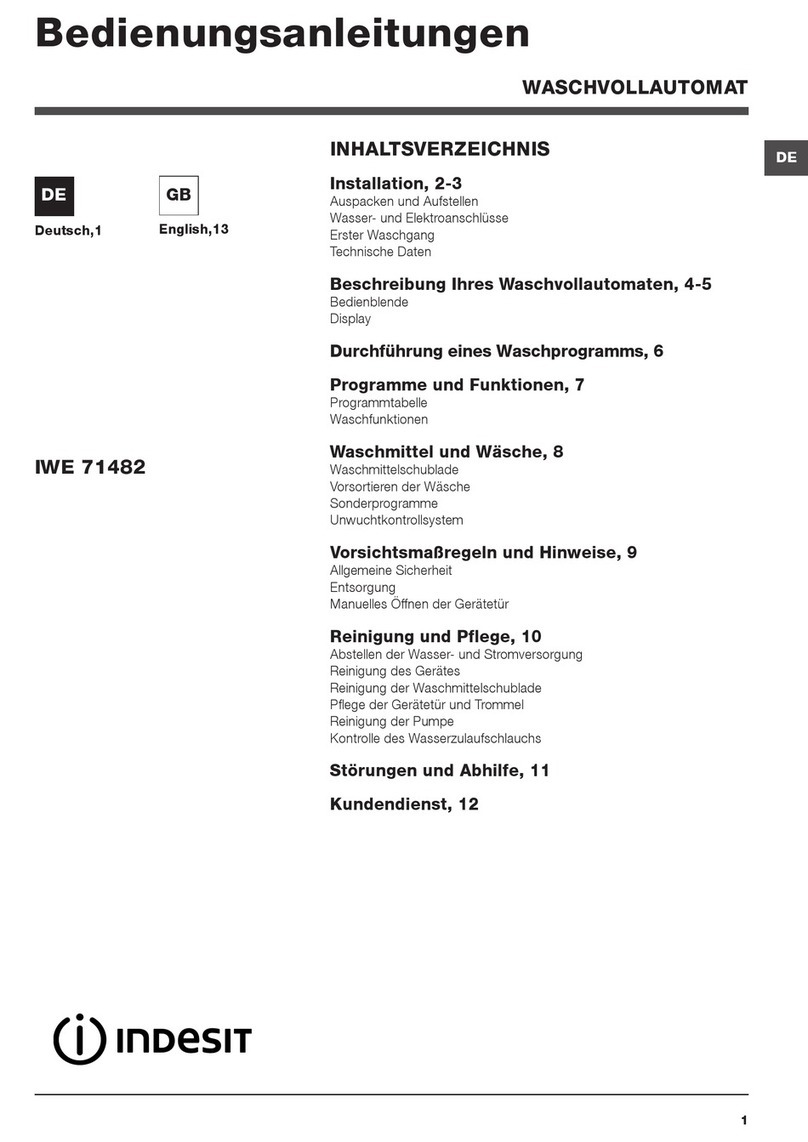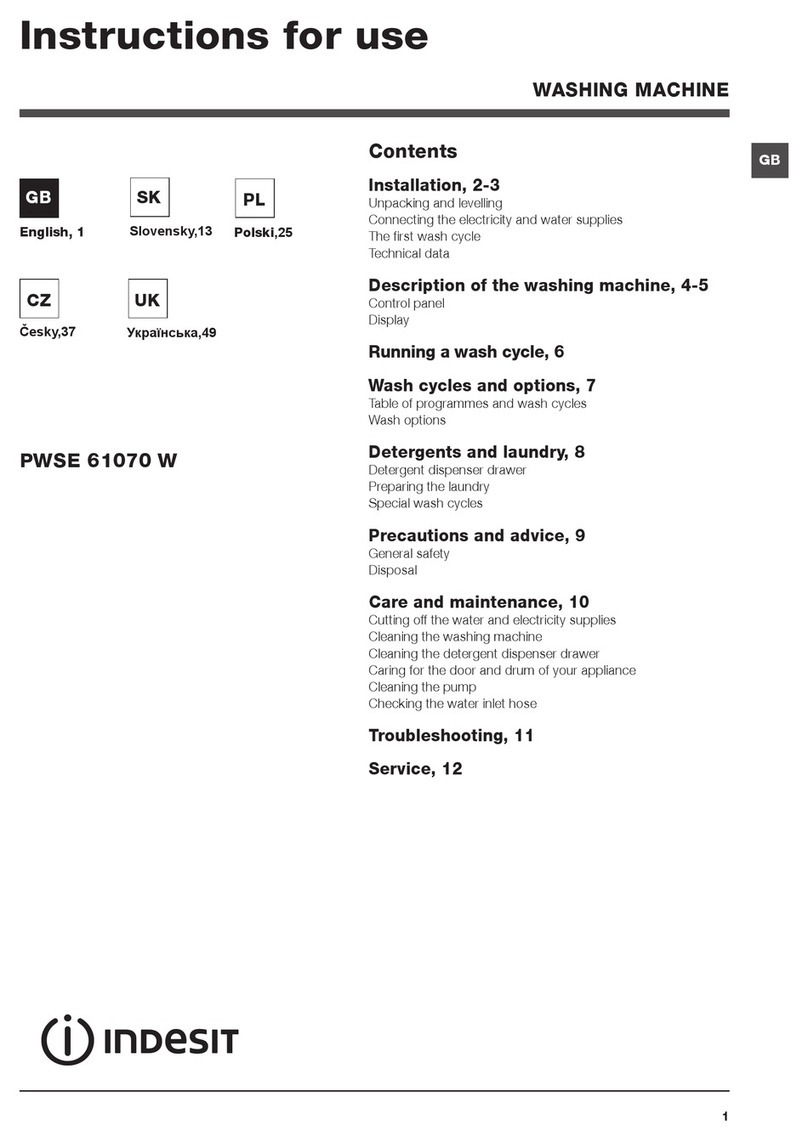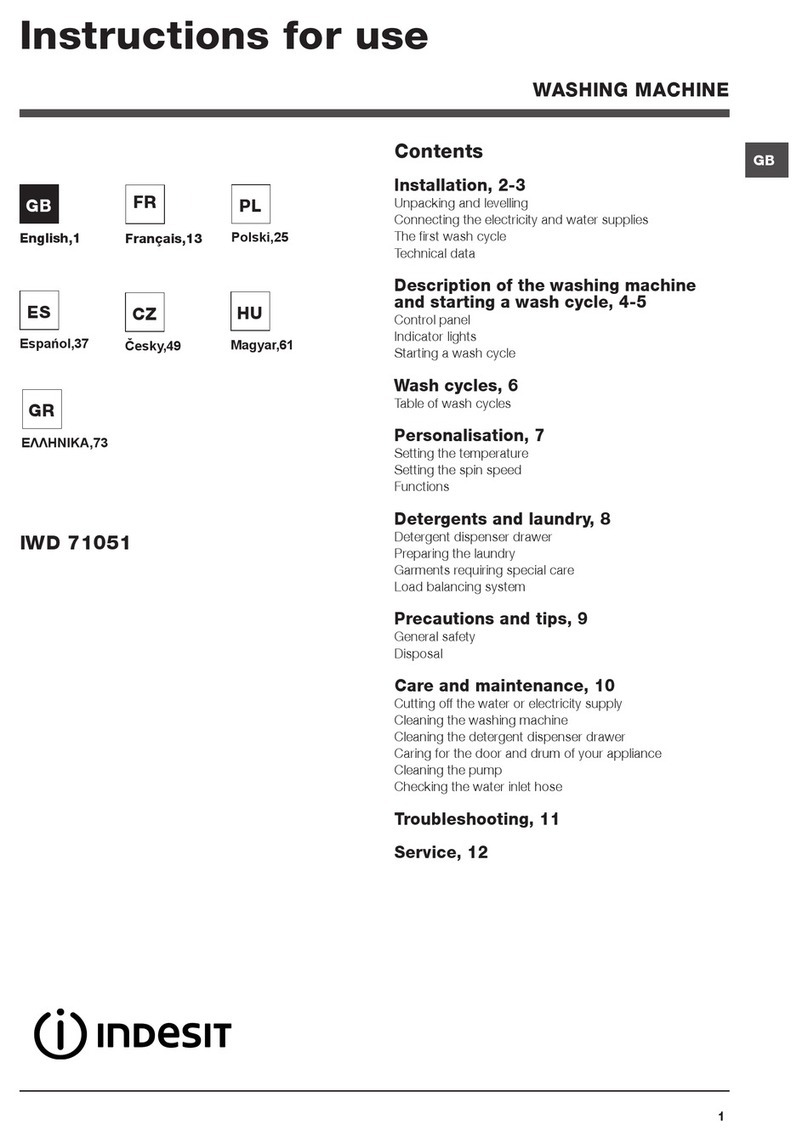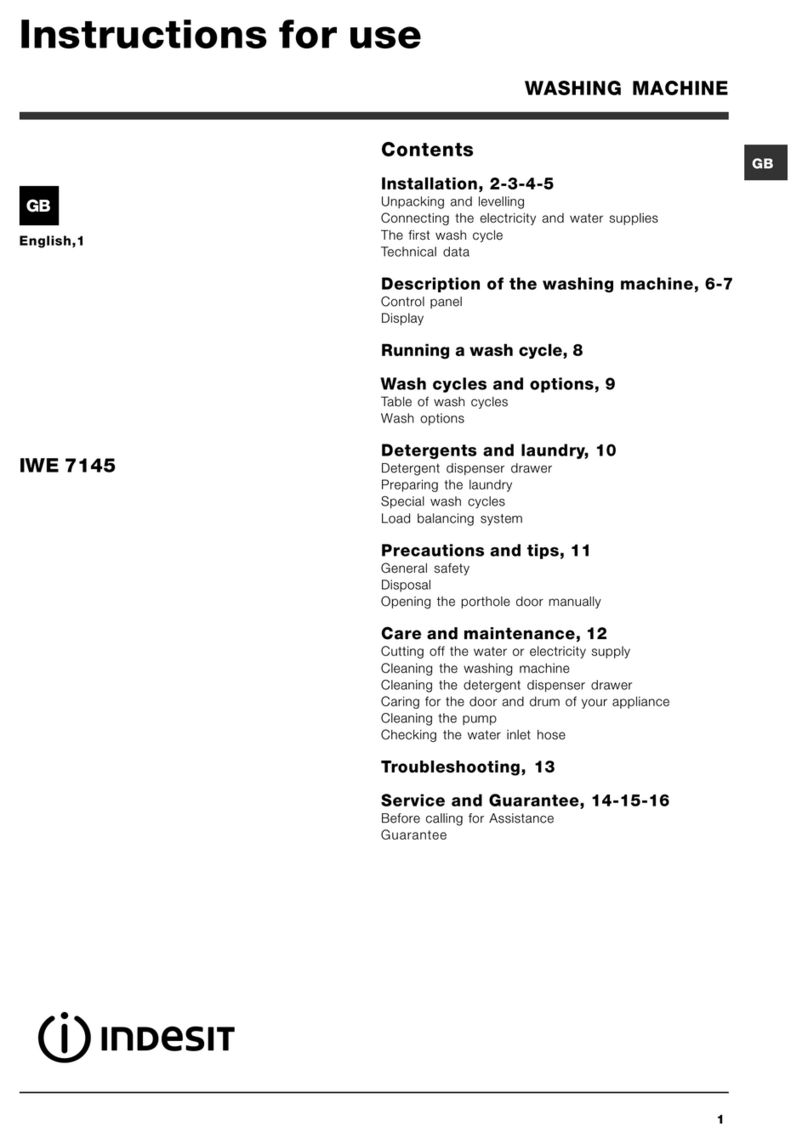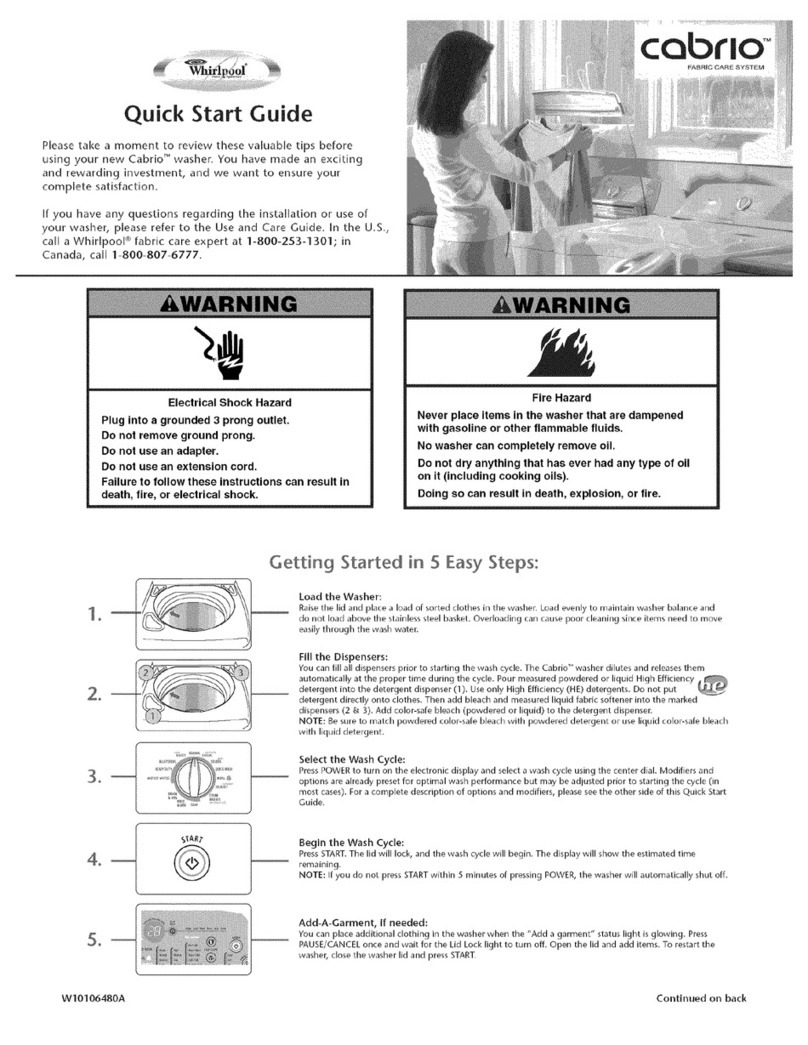GB
GB
1
English,1
Contents
Installation, 2-3
Unpacking and levelling
Connecting the electricity and water supplies
Technical details
Description of the machine, 4-5
Self-cleaning detergent dispenser drawer
Control panel
Load balancing system
Running a ash cycle, 6
Wash programmes, 7
Detergents and laundry, 8
Preparing the laundry
Washing recommendations
Precautions and advice, 9
eneral safety
Disposal
Saving energy and respecting the environment
Drip-tray system
Care and maintenance, 10
Cutting off the water or electricity supply
Cleaning the machine
Cleaning the detergent dispenser drawer
Caring for the door and drum of your appliance
Cleaning the pump
Checking the water inlet hose
Troubleshooting, 11
Service, 12
WASHING MACHINE
SISL 126
Instructions for use
GB
Italiano,13
I
Downloaded From WashingMachine-Manual.com Manuals
+%
1%
SISL 126
Dimensions
59.5 cm wide
85 cm high
40 cm deep
Capacity from 1 to 4,5 kg
Electric
connections
please refer to the technical data plate
fixed to the machine
Water
connections
maximum pressure 1 MPa (10 bar)
minimum pressure 0.05 MPa (0.5 bar)
drum capacity 40 litres
Spin speed up to 1200 rpm
Control
programmes
according to
EN 60456
directive
programme ;
run with a load of 4,5 kg.
This appliance is compliant with the
following European Community
Directives:
- 73/23/CEE of 19/02/73 (Low
Voltage) and subsequent amendments
- 89/336/CEE of 03/05/89
(Electromagnetic Compatibility) and
subsequent amendments
- 2002/96/CE
Connecting the drain hose
Connect the drain hose,
without bending it, to a
draining duct or a wall
drain situated between
65 and 100 cm from the
floor;
alternatively, place it
over the edge of a
basin, sink or tub,
fastening the duct
supplied to the tap (see
figure). The free end of
the hose should not be
underwater.
We advise against the use of hose extensions; if it
is absolutely necessary, the extension must have the
same diameter as the original hose and must not
exceed 150 cm in length.
Electrical connections
Before plugging the appliance into the electricity
socket, make sure that:
the socket is earthed and complies with all
applicable laws;
the socket is able to withstand the maximum
power load of the appliance as indicated in the
Technical data table (see opposite);
the power supply voltage falls within the values
indicated in the Technical data table(see opposite);
the socket is compatible with the plug of the
appliance. If this is not the case, replace the
socket or the plug.
The machine must not be installed outdoors, even
in covered areas. It is extremely dangerous to leave
the appliance exposed to rain, storms and other
weather conditions.
The mains socket must remain within easy reach
after the washing machine has been installed.
Do not use extension cords or multiple sockets.
The cable should not be bent or compressed.
The power supply cable must only be replaced by
authorised technicians.
Warning! The company shall not be held responsible
in the event that these regulations are not respected.
Downloaded From WashingMachine-Manual.com Manuals
508566button
DOOR
LOCKED red
indicator
light
WASHING TIME
INDICATOR
lights
START DAILY
WASH 30
PROGRAMME
button
START DELICATES
PROGRAMME
button
START WHITE
COTTON
PROGRAMME
button
START COLOUR
MIX EASY-IRON
PROGRAMME
button
Control panel
ON/OFF button: press this to switch the machine on or off.
When the machine is switched on, the buttons
used to start various programmes begin to flash,
while the washing time indicator lights illuminate in
a fixed manner.
To cancel the cycle, press and hold the on/off button
for approximately 2 seconds while the wash cycle is
in progress.
The indicator light will flash for a few seconds
and the machine will automatically drain the water in
the tub.
DOOR LOCKED red indicator light:
when the indicator light is illuminated the door is
locked to prevent it being opened accidentally; to
avoid damaging the appliance, wait for the light to
switch off before opening the door after the cycle
has ended or when the cycle is paused. The light
will remain lit for approximately two minutes after
the washing programme has finished.
Rapid flashing of the DOOR LOCKED indicator light
indicates a fault (see Troubleshooting).
START PROGRAMME buttons:
press one of these to start the selected washing
programme.
- button lit in a fixed manner: programme in progress.
- buttons flashing: awaiting selection.
WASHING TIME INDICATOR lights: these light up
in sequence to indicate the progress of the washing
programme. At the end of the programme all
the indicator lights begin to flash.
For further details, please refer to the chapter entitled
Running a wash c cle.
Load balancing system
To avoid excessive vibrations before every spin, the
machine distributes the load in a uniform manner by
rotating the drum continuously at a speed which is
slightly greater than the washing rotation speed.
When, despite repeated attempts, the load is not
perfectly distributed, the machine spins at a lower
speed than stated for the wash cycle.
If the load is excessively unbalanced, the machine
performs the distribution process instead of spinning.
Balancing attempts may increase the total duration of
the cycle, up to a maximum of 10 minutes.
Downloaded From WashingMachine-Manual.com Manuals
$
#
>0=for information relating to excluding the spin cycle in the delicates programme, please refer to the
Delicates 30° paragraph further down the page.
**Note: for information relating to rinsing hand-washed clothes in cold water, please refer to the
Daily wash 30 / Cold water rinse paragraph further down the page.
WHITE COTTON 60°
Designed for the washing of all durable white cotton
garments. Higher washing temperatures offer improved
washing results in Class A appliances.
COLOUR MIX 40° EASY-IRON
This programme can be used to wash all your coloured
garments, whether cotton or synthetic fabric. The spin
cycle is carefully controlled during the entire wash cycle,
so as to reduce the formation of creases in the fabric
and make it easier to iron.
Cotton and synthetic garments can be washed at the
same time.
DELICATES 30°
A cycle designed for the washing of all woollen, silk and
delicate garments. As these garments have different
features, this programme requires an activation
process which is different from the others:
+ DELICATES CYCLE WITH FINAL SPIN (for
woollen garments): press the START DELICATES
PRO RAMME button. After approximately 3
seconds, the START DELICATES PRO RAMME
and START DAILY WASH PRO RAMME buttons
begin to flash. Press the START DELICATES
PRO RAMME button to perform the wash, which
ends with a delicate spin cycle. This programme
includes drum movements which have been carefully
researched to remove excess water from the fabric,
thereby reducing friction and helping to protect your
woollen garments.
+ DELICATES CYCLE WITH SPIN PHASE
EXCLUDED (for silk and viscose garments and for
curtains; not to be used for washing wool):
press the START DELICATES PRO RAMME
button. After approximately 3 seconds, the START
DELICATES PRO RAMME and START DAILY
WASH PRO RAMME buttons begin to flash. Press
the START DAILY WASH PRO RAMME button to
perform the wash without the final spin cycle. At the
end of the cycle, the machine will automatically drain
the water contained in the drum. We recommend that
the garments are removed from the washing machine
straight away, in order to limit the formation of creases.
DAILY WASH 30 COLD WATER RINSE
This programme can be used to wash lightly soiled
cotton or synthetic fabrics, or garments with the "wash
at 30°" instruction on the label, in just 30 minutes. It
is also possibile to rinse cotton or synthetic garments
which have been washed by hand (this does not include
wool or silk).
Thanks to its special sensors, the washing machine
is able to recognise when the garments placed in the
drum have detergent on them.
- if no detergent is detected on the clothes, the DAILY
WASH 30' cycle will be performed;
- if detergent is detected (cloths which have been
washed by hand), the COLD WATER RINSE cycle will
be performed automatically.
AUTOMATIC RINSE MANAGEMENT
The rinse function is monitored and controlled in every
programme by special sensors. If the garments are
very soapy at the end of the wash, the rinse cycle
will be extended automatically until the detergent is
removed completely. In this case the wash
programme duration may be slightly increased in relation
to the information given in the table of programmes.
The duration of the programmes indicated in the table are for guidance purposes onl , and are calculated based on an average load quantit .
Button Fabrics Max.
load
(kg) Te m p e r a tu r e Spin
speed
(rpm)
Cycle
duration
(minutes) Wash cycle description
WHITE COTTON
Durable white cotton 4,5 60°C 1200 150 Wash cycle, rinse cycles, intermediate
and final spin cycles
COLOR MIX 40° / EASY IRON
Coloured cotton
and synthetics 3 40°C 1000 104 Wash cycle, rinse cycles and delicate
spin cycle
DELICATES
Wool (final delicate spin
cycle) 1 30°C 600 55 Wash cycle, rinse cycles and delicate
spin cycle
Silk and curtains (without
final spin cycle) 130°Cno*50
Wash cycle, rinse cycles and drainage
DAILY WASH / COLD WATER RINSE
Cotton and synthetics 330°/cold
water** 800 30
Wash cycle (only if the "Rapid wash"
programme activated), rinse cycles,
delicate spin cycle
+
+
Downloaded From WashingMachine-Manual.com Manuals
)
'%%(
This machine was designed and constructed in
accordance with international safety regulations. The
following information is provided for safety reasons
and must therefore be read carefully.
General safety
This appliance was designed for domestic use only.
The machine must only be used by adults, in
accordance with the instructions given in this manual.
Do not touch the machine when barefoot or with
wet or damp hands or feet.
Do not pull on the power supply cable when
unplugging the appliance from the electricity
socket. Hold the plug and pull.
Do not touch the drained water as it may reach
extremely high temperatures.
Never force the porthole door. this could damage
the safety lock mechanism designed to prevent
accidental opening.
If the appliance breaks down, do not under any
circumstances access the internal mechanisms in
an attempt to repair it yourself.
Always keep children well away from the appliance
while it is operating.
The door can become quite hot during the wash cycle.
If the appliance has to be moved, work in a group
of two or three people and handle it with the
utmost care. Never try to do this alone, because
the appliance is very heavy.
Before loading laundry into the washing machine,
make sure the drum is empty.
Disposal
Disposing of the packaging materials: observe local
regulations so that the packaging may be re-used.
The European Directive 2002/96/EC on Waste
Electrical and Electronic Equipment, requires that
old household electrical appliances must not be
disposed of in the normal unsorted municipal
waste stream. Old appliances must be collected
separately in order to optimise the recovery and
recycling of the materials they contain and reduce
the impact on human health and the
environment. The crossed out "wheeled bin"
symbol on the product reminds you of your
obligation, that when you dispose of the appliance
it must be separately collected.
Consumers should contact their local authority or
retailer for information concerning the correct
disposal of their old appliance.
Saving energy and respecting the
environment
Saving detergents, ater, energy and time
To avoid wasting resources, the washing machine
should be used with a full load. One full load instead of
two half loads saves up to 50% of the energy used.
Treating stains with a stain remover, or leaving
them to soak before they are washed, reduces the
need to wash the garments at high temperatures.
Use the correct quantity of detergent, in
accordance with the water hardness, how soiled
the garments are and the amount of laundry you
have, in order to avoid wastage and to protect the
environment: although they are biodegradable,
detergents still contain ingredients which alter the
balance of nature. Avoid using fabric softener
wherever possible.
If you use your washing machine between late
afternoon and the early hours of the morning, you will
help to reduce the peak load of the electricity board.
Drip-tray system
The machine is fitted with a drip-tray system on the
inside of the door, which catches any residual drips of
water at the end of the cycle.
We recommend that the dampness level of the
sponge inside the drip-tray compartment is checked
regularly. If necessary, it may be cleaned or replaced
as follows:
1. Remove the
compartment by applying
a light pressure to the
lower part.
2. Remove the sponge
inside it, rinse it under
running water and wring it
out thoroughly. It may
also be replaced with one
of the spare sponges
provided.
3. Place the sponge back inside the compartment.
4. Replace the compartment in the door, making
sure the springs on the door are correctly
inserted into the corresponding slots on the
compartment.
5. Make sure that the compartment is slotted back
into position correctly.
Downloaded From WashingMachine-Manual.com Manuals
+,
',=
+ %
A
+ ! ;A
+ %
B%4%2
%!CA
+!
%%A
+ %
%A
+(,%
!A
+ 4A
+55259%
%!A
+A
Your washing machine could occasionally fail to work. Before contacting the Technical Assistance Centre
(see Service), make sure that the problem is not easily solved using the following list.
Possible causes / Solutions:
The appliance is not plugged into the socket fully, or is not making
contact.
There is no power in the house.
The washing machine door is not closed properly.
The ON/OFF button has not been pressed.
The START PRO RAMME buttons have not been pressed (they
are still flashing).
The water tap has not been opened.
The water inlet hose is not connected to the tap.
The hose is bent.
The water tap has not been opened.
There is no water supply in the house.
The pressure is too low.
The START PRO RAMME buttons have not been pressed (they
are still flashing).
The drain hose is not fitted at a height between 65 and 100 cm
from the floor ( see Installation).
The free end of the hose is under water (see Installation).
The wall drainage system is not fitted with a breather pipe.
If the problem persists even after these checks, shut off the water
tap, switch the appliance off and contact the Technical Assistance
Service. If the dwelling is on one of the upper floors of a building,
there may be problems relating to water drainage, causing the
washing machine to fill with water and drain continuously. Special
anti-draining valves are available in shops and help to avoid this
inconvenience.
The drain hose is bent (see Installation).
The drainage duct is clogged.
The protective screws (used during transportation) were not
removed when the appliance was installed. Remove the screws
(see Installation).
The machine is not level (see Installation).
The machine is trapped between cabinets and walls (see
Installation).
The water inlet hose is not screwed on properly (see Installation).
The detergent dispenser is blocked (to clean it, see Care and
maintenance).
The drain hose is not fixed in place properly (see Installation).
The drip-tray system is full. Clean the sponge or replace it (see
"Precautions and advice").
Switch off the machine and unplug it, wait for approximately 1
minute and then switch it back on again. The wash cycle will have
to be started again from the beginning. If the problem persists,
contact the Technical Assistance Service.
The detergent is not suitable for machine washing (it should bear
the description for washing machines or hand and machine
wash, or similar instructions).
Too much detergent was used.
Downloaded From WashingMachine-Manual.com Manuals
